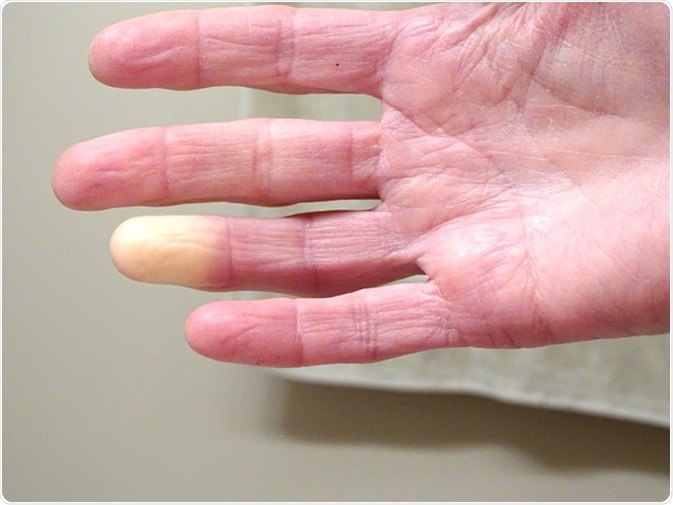Raynaud's syndrome, also called Raynaud's phenomenon, is an exaggerated response to cold or stress induced vasospasm of cutaneous blood vessels.
The sudden constriction of blood vessels leads to poor circulation or inadequate oxygenation of the blood within the tissues, which in turn causes bluish discoloration and numbness of the affected areas, most commonly the fingers and toes.
Even though the syndrome is not disabling, it can severely affect the patient’s quality of life. While there is no standard diagnostic test, the condition has been found to be more prominent in women than in men.
The vasospasm or constriction of blood vessels protects the body from excessive heat loss, and hence can be observed as a compensating mechanism. This protective mechanism is mediated by the release of norepinephrine from the sympathetic nervous system.

Adult hand with Raynaud's Syndrome / Phenomenon. Image Credit: Barb Elkin / Shutterstock
What are the Causes of Raynaud’s Syndrome?
Raynaud’s syndrome can be either idiopathic (primary) or it can occur due to several underlying diseases or conditions (secondary). Some of the common causes of secondary Raynaud’s phenomenon are scleroderma, systemic lupus erythematosus, rheumatoid arthritis and Sjogren's syndrome.
The idiopathic or primary form of the disease has mild outcomes and usually resolves with non-pharmacological approaches. However, the secondary form can lead to aggravation of symptoms and can have serious implications.
The secondary form is more common in patients suffering from connective tissue disease, and the condition worsens in the presence of external strain (physical/chemical). The secondary form can progress to more severe forms, such as digital necrosis and ulceration, which leads to disability. Hence, a detailed investigation for prompt diagnosis of the underlying disease is necessary. Complete medical anamnesis, physical examination and pathological tests should be undertaken for disease assessment.
Raynaud’s Phenomenon Video – Brigham and Women’s Hospital
What are the Risk Factors for Developing Raynaud’s Syndrome?
- Vascular abnormalities – Problems associated with the blood vessel wall or vascular tone.
- Smoking – It can increase the risk of digital ischemia.
- Gender – Raynaud’s syndrome is more common in women than men.
- Genetic factors
What Complications are Associated with Raynaud’s Syndrome?
Even though the condition is not life-threatening, severe cases can lead to certain complications:
- Deformation of fingers and toes – Occurs when blood supply is hampered for a prolonged period of time.
- Development of gangrene and cutaneous ulcers – Occurs when the oxygen supply to a particular area is completely blocked. These are serious conditions, which can eventually lead to amputation, if severe enough.
- Chilblains – A possible manifestation of Raynaud’s syndrome. It occurs on repeated exposure to cold and is characterized by inflammation and red, itchy skin.
How is Raynaud’s Syndrome Treated?
Patients with Raynaud’s syndrome may be treated non-pharmacologically by making certain lifestyle and environmental changes. In addition to non-pharmacological treatment, patients may also receive pharmacological therapy where applicable.
What are the Non-Pharmacological Treatment Approaches for Raynaud’s Syndrome?
- Avoiding extremely cold temperatures.
- Using appropriate clothing and heating devices to protect against cold temperatures.
- Adopting a healthy lifestyle and avoiding emotional stress.
- Smoking cessation.
- Discontinuing drugs that may cause vasospasm, if possible.
- Avoiding frequent use of vibrating tools, such as jackhammers.
What Pharmacological Treatments are Used for Raynaud’s Syndrome?
- Calcium channel antagonists are the mainstay of treatment. However, the adverse effects associated with these drugs limit their usage.
- Other treatment options - Even though these drugs are unable to completely abolish vasospastic attacks, they play an important role in reducing the severity and frequency of attacks:
- Nitroglycerine ointments
- Prostacyclins and endothelin receptor antagonists
- Phosphodiesterase inhibitors
- Serotonin receptor antagonists
Future Perspective
With the plethora of symptoms and underlying conditions that are associated with Raynaud’s syndrome, prompt diagnosis and effective treatment pose a major challenge. Dealing with cases of secondary Raynaud’s phenomenon is particularly difficult due to the various structural abnormalities that may be associated.
Research focusing on elucidating the exact mechanisms regulating the various vasoconstriction and vasodilation pathways is vital. This can ultimately deliver promising agents for the treatment of Raynaud’s syndrome, especially the secondary form of the disease.
Last Updated: Feb 27, 2019